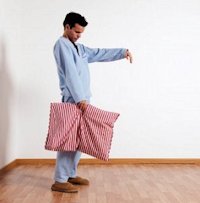
|
Some Common Myths Thought to be True - Myth 60
Myth 60: Waking Sleepwalkers is Harmful to Them
There are conflicting viewpoints on whether it is harmful to wake a
sleepwalker. Some experts say that sleepwalkers should be gently guided back to
bed without waking them. Others counter that idea and state that waking a
sleepwalker may result in their disorientation, but it is not harmful.
|
| Sleepwalker | |
|
Sleepwalking, also known as somnambulism or noctambulism, is a sleep disorder
belonging to the parasomnia family. Sleepwalkers arise from the slow wave sleep
stage in a state of low consciousness and perform activities that are usually
performed during a state of full consciousness. These activities can be as
benign as sitting up in bed, walking to the bathroom, and cleaning, or as
hazardous as cooking, driving, violent gestures, grabbing at hallucinated
objects, or even homicide.
|
|
| ⇦ Back to Myth 59 Return to Myth Choices Page 5 On to Myth 61 ⇨ | |